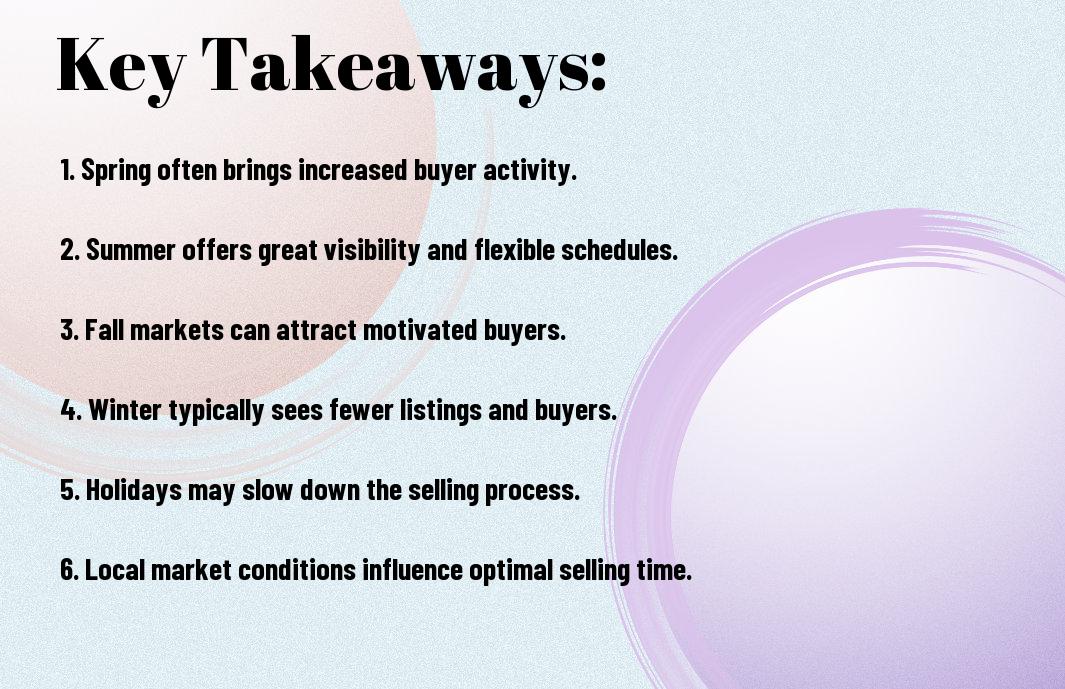You may be wondering when the best time is to sell your home for maximum profit and quick turnover. Timing can significantly impact the sale price and the number of interested buyers, making it important to choose the right season. In this post, we will explore the different seasons, highlighting the advantages and disadvantages of each, helping you make an informed decision about when to list your property. Let’s investigate the seasonal trends that can work in your favor!
Key Takeaways:
- Spring and early summer are often viewed as the most favorable times to list a home, as buyers are typically more active during these months.
- Consider local market trends, as seasonal patterns can vary by region, impacting the ideal timing for a sale.
- Holidays and winter months generally see lower buyer activity, making it less optimal for listing a property unless necessary.
Understanding Seasonal Trends
While many factors can influence your home sale, understanding the seasonal trends can drastically impact your selling strategy. Each season tends to bring different behaviors and buyer patterns, and knowing when to list your home can yield results that align with your goals. During certain times of the year, you may find an influx of eager buyers, while at other times, the market can feel quite sluggish. By aligning your sale with these seasonal trends, you can maximize your home’s appeal and accessibility to potential buyers.
Spring: A Time for New Beginnings
Above all seasons, spring is often seen as a time for new beginnings, and this sentiment extends to the housing market. As the weather warms and flowers bloom, buyers start to feel rejuvenated and are more inclined to search for their dream homes. Many families prefer to move during this season in preparation for the new school year, making it an ideal time to showcase your property. To take advantage of this uptick in buyer enthusiasm, ensure your home is inviting by enhancing curb appeal and making necessary repairs during the spring months.
Summer: Peak Selling Season
Around the summer months, the housing market typically reaches its peak, characterized by an increased number of active buyers. The longer days and pleasant weather encourage house hunting, and families often look to finalize their purchases before the new school year begins. This season offers a strategic opportunity for you as a seller to present your home in its best light, perhaps by hosting open houses or showcasing outdoor spaces. With buyers more inclined to make offers during these warmer months, you can capitalize on the heightened competition.
Spring cleaning and staging can make your property shine during the summer, and you might find that your home gets an increase in foot traffic and interest. Moreover, with an expanding pool of buyers willing to invest, not only could you receive multiple offers, but you may also achieve a higher selling price as buyers become eager to compete for premium properties. Knowing this, focusing your efforts on preparatory tasks in the spring can really set you up for success come summer.
The Fall Market
Clearly, the fall market can offer unique advantages when it comes to selling your home. As the weather cools and the leaves begin to change, potential buyers may be more motivated to find a place before the holiday season. With fewer homes on the market, you often face less competition, allowing your property to stand out to discerning buyers. Furthermore, fall buyers are typically more serious and ready to make a purchase, crafting a win-win scenario for you. If you’re pondering whether to wait for spring, you might want to investigate Why Is Spring the Best Time to Sell a House? to compare seasonal benefits.
Benefits of Selling in Autumn
Between shorter days and the festive spirit that autumn brings, your home can shine in a different light. Many buyers appreciate the cozy aesthetics of fall, so consider staging your home with seasonal decorations that highlight its best features. Furthermore, the market tends to slow down by winter, meaning buyers who are actively searching in the fall are often more motivated, which could lead to quicker sales and potentially better offers. In addition, many families prefer to move before the school year ends, allowing you to tap into that urgency.
Challenges of a Fall Sale
Between the vibrant season of autumn and the impending winter months, there are challenges that you should be aware of when selling your home. One major factor is that daylight hours are limited, and shorter days can make it difficult for prospective buyers to view your home during sunlight hours. Additionally, as fall progresses, many buyers may be reluctant to move with the holiday season approaching, leading to a potential decrease in buyer activity as the year winds down.
Challenges of a fall sale also include the unpredictable weather. Rain, wind, and early snow can impact curb appeal, making it important for you to keep your property looking its best despite the changing conditions. Moreover, with numerous events and holidays occurring during this time, potential buyers could be easily distracted and may postpone their home search. This means it’s vital for you to properly market your home to grab the attention of serious buyers amidst the distractions of the season.
Winter Considerations
Now, when considering selling your home during the winter months, it’s important to recognize the unique dynamics of this season. Winter can often lead to a smaller pool of potential buyers due to cold weather and the holiday season, which may discourage families from actively shopping for a new home. However, those who are searching during this time are typically more motivated and serious about making a purchase. If you position your home effectively, winter can present a golden opportunity to attract these eager buyers who want to finalize their search before the market picks up in spring.
Limited Buyers but Eager Ones
At this time of year, while there may be fewer buyers in the marketplace, they often come with a sense of urgency. Many individuals and families who are house hunting in winter are usually facing deadlines, whether it be due to job relocations, personal circumstances, or the desire to settle before the new school year begins. This means that your home has the potential to stand out to those who are committed to making a decision. With a focused marketing strategy, you can access a niche audience that sees the value in acting quickly, potentially leading to competitive offers.
Preparing Your Home for Winter Showings
Beside the limited buyer pool, how you present your home during winter showings can significantly influence a buyer’s perception and emotional connection to your property. Preparing your home entails not only making it warm and inviting but also ensuring it portrays a sense of coziness that appeals to prospective buyers. You should keep walkways clear of snow and ice, ensure heating systems are in good working order, and add small touches such as inviting aromas from baked goods to create a welcoming ambiance.
It is also imperative to consider the visual aspects of your home. Ensure that all lights are functioning properly and consider adding warm lighting fixtures to create an inviting atmosphere. Showcase your home’s best features by minimizing clutter and utilizing seasonal decorations that enhance, rather than distract from, your space. Additionally, keep your windows clean to allow for maximum natural light, creating a bright and airy environment amidst the winter gloom. By thoughtfully preparing your home, you can create a compelling presentation that captivates potential buyers, even during the cold and dreary months.
Regional Variations in Selling Seasons
Keep in mind that the timing of your home sale can vary significantly depending on your location. Understanding regional trends is important to maximizing your selling potential. For instance, urban markets often see a surge in sales during spring and early summer when families are looking to settle before the new school year. In contrast, rural areas may experience different trends that align more closely with farming seasons or local events. To gain deeper insights into when is the best time to sell a house, check out this Seasonal Insights that can help you gauge the right time for your unique setting.
Urban vs. Rural Markets
Regional differences between urban and rural markets can greatly influence your selling strategy. In metropolitan areas, you may find that demand peaks during warmer months, when more potential buyers are actively searching for homes. Conversely, rural markets might experience fluctuations based on local agricultural schedules, tourism, or seasonal festivals that draw in visitors and potential buyers. Understanding these dynamics will help you plan your listing and pricing strategy more effectively.
Climate Impact on Selling Times
To further refine your approach, consider the impact of climate on your selling timeline. In regions with extreme weather conditions, such as heavy snow in winter or intense heat in summer, you may find that buyer activity slows down significantly. For example, areas with milder climates often experience year-round buyer engagement, while those in harsher environments might see a clear peak in spring and early fall, when conditions are more favorable. By being aware of these variances, you can better schedule your listing to align with more active selling periods.
It’s also beneficial to analyze local climate patterns to gauge when buyers are most comfortable touring homes. If you live in an area that experiences heavy winter snowfall, you may want to list your home in the early spring when the weather starts to become more inviting. On the other hand, hot and humid regions might have better turnout in the fall when temperatures are more moderate. Tailoring your selling schedule to mirror the comfort levels of potential buyers can significantly impact the success of your sale.
Pricing Your Home by Season
Many homeowners often overlook the impact of seasonal changes on their property’s price. As the seasons change, so do buyer preferences and behaviors. In spring, for instance, buyers are typically more active, motivated by the warm weather and the desire to settle into a new home before school starts. Therefore, setting competitive prices during this season can lead to quicker sales and higher offers. Conversely, during winter, the market cools down and you may need to adjust your pricing strategy to attract buyers who are willing to brave the cold weather.
Setting Competitive Prices
The key to effectively pricing your home lies in understanding the current market conditions, which are greatly influenced by the season. During peak selling months, it’s important to evaluate comparable properties in your area and set your price slightly below or in line with those listings to stand out. Errors in pricing can lead to extended time on the market, which may lead to the perception that your home is undesirable. You should consider the features of your home and any seasonal trends that may affect its perception in the market.
Timing Price Reductions
By closely monitoring your home’s time on the market, you can determine the ideal moment for price reductions. If your property has been listed for several weeks without substantial interest or offers, it may be time to reevaluate your strategy. Timing is necessary—research shows that the most effective reductions occur in the late summer months when inventory starts to rise and competition intensifies.
Due to the fluctuating nature of the real estate market, aligning your price reductions with buyer behavior can have a significant impact on your sale. For instance, if you notice a drop in showings towards the end of summer, it may indicate that buyers are moving on to other properties. Hence, making a strategic price reduction around this time can reignite interest and prompt potential buyers to reconsider your home. Always keep an eye on seasonal trends and adjust your pricing accordingly to maximize your chances of a timely sale.
Preparing for Sale: Timing and Strategy
Your approach to selling your home should be as strategic as it is proactive. Timing can significantly impact how quickly and effectively your home sells, but it is imperative to combine this with a robust preparation strategy. Before you schedule any showings or open houses, take a moment to assess the state of your home and the local real estate market. Understanding local trends, such as when buyers are most active and what their preferences are, will serve you well in crafting a sales strategy that aligns with optimal selling periods in your area.
Essential Steps Before Listing
Besides monitoring the seasonal aspects of home sales, you need to take practical steps to ensure your home stands out to potential buyers. Start by decluttering and deep cleaning your space, making sure to address any minor repairs that could detract from your home’s appeal. Consider staging your home to present it in the best light, showcasing its potential and creating an inviting atmosphere. This preparation not only enhances your home’s attractiveness but also helps you gauge its current value within the market.
Marketing Your Home Effectively
Effectively marketing your home is a vital component of your overall sales strategy. You want to make sure that your listing reaches the right audience at the right time. Utilize high-quality photographs and detailed descriptions that highlight your home’s best features. Leveraging both online platforms and traditional marketing channels can expand your reach and encourage potential buyers to take interest. It is also wise to consider hosting open houses on weekends or during peak times when you can attract the most traffic.
With a well-executed marketing plan, you can create buzz around your listing and generate interest among prospective buyers. Engage with social media platforms, local community groups, and real estate websites to share your listing widely. By effectively showcasing your home through various channels, you enhance the likelihood of attracting serious buyers, making it easier for you to sell your home quickly and at a desirable price.
Final Words
With this in mind, understanding the best seasons to sell your home can significantly enhance your chances of achieving a successful sale. By aligning your selling timeline with market trends, you can attract the right buyers and potentially secure a better price for your property. Spring often presents the most favorable conditions, as buyers are more actively searching for homes to settle into by summer. However, depending on your local market, late summer and early fall can also be advantageous, particularly for families seeking to move before the school year begins.
Your choice of when to sell should factor in not just seasonal trends, but also your personal circumstances and the unique attributes of your home. If your property stands out in any way—whether it’s its location, condition, or special features—these advantages can play a significant role in its attractiveness, irrespective of the time of year. Ultimately, by being informed about these timing strategies, you can make better decisions that align with both your needs and the market dynamics, leading to a successful home selling experience.
Q: What are the best seasons to sell my home?
A: The spring and summer months are generally considered the most favorable for selling a home. During this time, typically from March to August, many buyers are actively looking to purchase due to favorable weather conditions and the desire to settle in before the school year begins. Additionally, homes often look more appealing when landscaping is in full bloom, which can enhance curb appeal and attract more potential buyers.
Q: How does market demand vary by season?
A: Market demand tends to fluctuate throughout the year, with higher activity in the spring and summer months as families look to move during the warmer weather. In contrast, fall and winter tend to see a slowdown in real estate transactions. This seasonal dip can result in fewer buyers in the market, which may affect the sale price and time on the market for your home. Understanding these trends can help you time your sale strategically for optimal results.
Q: Are there any benefits to selling my home during the off-season?
A: Selling your home during the off-season, such as late fall or winter, can have its advantages. There is typically less inventory on the market during these months, meaning your home may face less competition. Additionally, serious buyers tend to be more motivated during the off-season, which can lead to quicker offers. If your home is well-prepared and effectively marketed, it can stand out even in a less active real estate market.






